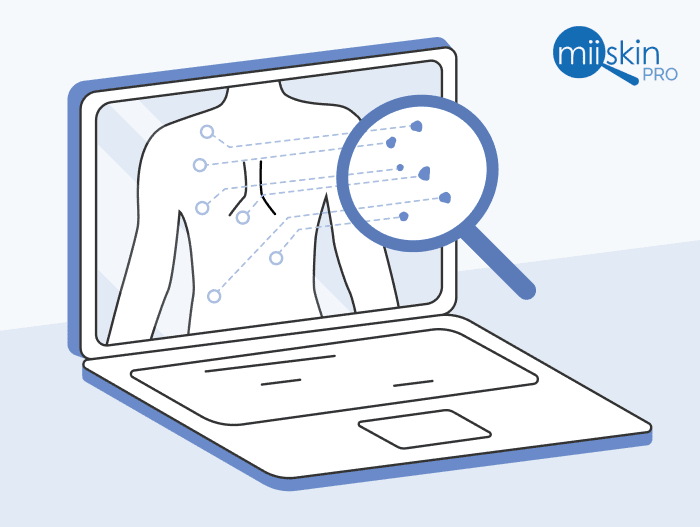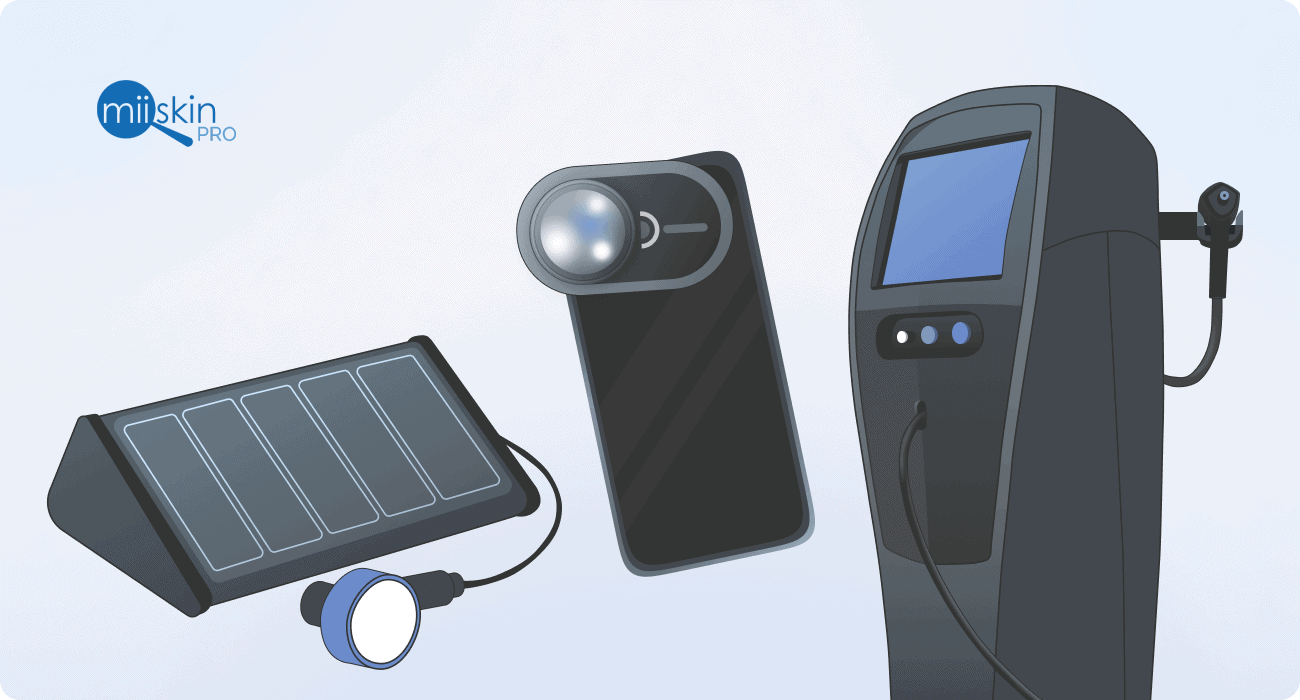Understanding dermatology software: The essential tools for modern clinics
Get an overview of the different types of software that you may need if you are planning to set up a private dermatology practice.
Table of content:
EMR and EHR software l Teledermatology software l Medical practice management software l E-prescription software l Software for medical billing l Dermoscopy software l Why Miiskin PRO is a smart all-in-one choice for modern dermatologists
In today’s fast-paced healthcare environment, dermatology software has become a cornerstone of successful, efficient, and patient-centered dermatology practices. From managing clinical documentation and capturing high-resolution skin images to enabling virtual consultations and streamlining billing, software solutions now power nearly every aspect of a dermatology clinic’s operations.
Whether you’re launching a new private practice or optimizing an existing one, choosing the right dermatology software is critical. The landscape includes everything from specialized EHRs and teledermatology platforms to imaging systems and revenue cycle management tools. Each software category plays a unique role in supporting clinical workflows, improving patient outcomes, and enhancing overall efficiency.
In this guide, we’ll break down the most important types of dermatology software, explain what they do, and help you determine which solutions are essential for your practice.
Types of software for dermatologists
Running a modern dermatology practice requires more than clinical expertise—it also depends on the right technology. From managing patient records to capturing clinical images and processing payments, dermatology software plays a crucial role in streamlining day-to-day operations.
Below are the core categories of software that dermatologists typically rely on to run an efficient, compliant, and patient-friendly practice. Each serves a specific function and can be tailored to fit the needs of solo practitioners, group clinics, or enterprise-level dermatology networks.
EMR/EHR software
Purpose:
EHR/EMR software are the foundation of clinical documentation in any medical practice. For dermatologists, they enable efficient recording of patient encounters, management of medical histories, digital imaging, prescriptions, and coordination with labs and pharmacies.
Essential for private practice? Yes — This is the core system for managing patient care and clinical records.
Main Features:
- Dermatology-specific templates for skin exams, lesion mapping, and procedure documentation
- Integration with pathology labs, imaging tools, and pharmacies
- E-prescribing capability
- Clinical decision support and alerts
- Patient portal access for secure communication and health record sharing
- Customizable forms and macros for fast note entry
Pricing:
- Ranges from $300–$800/month per provider, depending on features and vendor
- Additional fees for EPCS, lab interfaces, and data migration may apply
Vendors:
- Modernizing Medicine EMA (built specifically for dermatologists)
- AdvancedMD (modular and scalable)
- AthenaOne (general EHR with dermatology options)
Teledermatology software
Purpose:
Teledermatology software Enables dermatologists to consult with patients remotely, either through asynchronous (store-and-forward) or synchronous (live video) visits. This technology increases patient access, improves scheduling flexibility, and can extend services to rural or underserved populations.
Essential for private practice? Strongly recommended — Particularly for modern, hybrid practices or those looking to grow with virtual care.
Main Features:
- Patient-facing app or web portal for secure image upload and case submission
- Provider dashboard for reviewing images, histories, and communicating with patients
- E-prescribing integration with pharmacies
- Secure messaging and follow-up tools
- Optional branding/customization for private practices
- Built-in billing and payment processing
- HIPAA and GDPR compliance
Pricing:
- Miiskin PRO: $10 per consult, no monthly fees
- Other platforms: Subscription-based or enterprise pricing, often starting around $200–$500/month per provider
Vendors:
- Miiskin PRO (pay-per-use model)
- FirstDerm (anonymous, store-forward model)
- DermEngine (enterprise-oriented, supports branded deployments)
FOR DERMATOLOGISTS IN USA
Want a steady stream of new patients every month?
Partner with Miiskin and start receiving a steady stream of new patients — simply by joining the platform!
✅ You must have a private practice
✅ You must have your own malpractice insurance (we can help you set-up one)
There’s no upfront subscription — just a $10 usage fee.
Boost your revenue starting today!
Medical practice management software (PMS)
Purpose:
Medical practice management software streamlines the business and administrative side of a dermatology practice. PMS software handles scheduling, patient communications, check-ins, insurance eligibility, and staff management.
Essential for private practice? Recommended for clinics seeing in-person patients. Not essential for virtual dermatology clinics.
Main Features:
- Appointment scheduling with calendar integrations and automated reminders
- Online check-ins, intake forms, and digital consent forms
- Insurance verification and eligibility checking
- Patient communication (SMS, email, phone integration)
- Referral and prior authorization tracking
- Reports and analytics for operational insights
Pricing:
- Typically $200–$400/month per provider
- Often bundled with EHR systems or sold as all-in-one platforms
Vendors:
- DrChrono (all-in-one EHR + PMS)
- Nextech (dermatology-specialized)
- CareCloud (modular and scalable)
E-prescription software
Purpose:
E-prescription software enables dermatologists to securely send prescriptions to pharmacies electronically. It improves accuracy, enhances patient safety, and streamlines the prescribing process—especially useful for practices offering virtual consultations or managing ongoing treatment plans.
Essential for private practice? Yes — E-prescribing is a fundamental capability for both in-person and teledermatology settings.
Main Features:
- Electronic transmission of prescriptions to retail or mail-order pharmacies
EPCS compliance for controlled substance prescriptions - Medication history and allergy checks
- Drug interaction alerts
- Refill management and prior authorization support
- Integration with EHR or teledermatology platforms
Pricing:
- Often bundled with EHRs or telehealth software
- Standalone e-prescribing modules typically cost $50–$200/month per provider, depending on features and EPCS compliance
Vendors:
- DrFirst (integrates with many EHRs and PM systems)
- Kareo Rx (part of Kareo’s EHR and billing ecosystem)
- DoseSpot (white-labeled and used by several EHR vendors)
Software for medical billing
Purpose:
Handles the financial operations of a dermatology practice, including charge capture, claims submission, denial management, patient collections, and reporting.
Essential for private practice? It depends. It’s essential for in-person clinics either as in-house software or outsourced service, RCM is crucial for maintaining revenue flow.
Main Features:
- Dermatology-specific coding tools (CPT, ICD-10)
- Insurance claim generation, submission, and status tracking
- Payment posting, billing reconciliation, and aging reports
- Patient payment portals and automated statements
- Denial management and appeals
- Integration with PMS and EHR systems
Pricing:
- Outsourced RCM: 4%–8% of monthly collections
- In-house software: Fixed monthly license per provider ($200–$500 typical)
Vendors:
- Kareo Billing (cloud-based, good for small practices)
- AdvancedMD RCM (fully integrated with their EHR)
- NueMD (easy to use, ideal for smaller practices)
Clinical Imaging and Dermoscopy Software
Purpose:
Used for capturing and managing high-resolution clinical and dermoscopic images. Dermatologists rely on these tools for lesion monitoring, mole tracking, patient education, and early detection of skin cancer.
Essential for private practice? No, but considered useful for dermatologists managing skin cancer or chronic conditions.
Main Features:
- Integration with handheld dermatoscopes and mobile cameras
- AI-powered lesion analysis for risk scoring and image triage
- Side-by-side comparisons for follow-up visits
- Body mapping and visual timelines of skin changes
- Secure cloud-based image storage with patient identifiers
- Annotation and labeling tools for clinical documentation
Pricing:
- Starts around $31 per month, per user
- Advanced AI or total-body photography features are priced higher for enterprise setups
Vendors:
- DermEngine (AI-driven and cloud-based)
- FotoFinder (premium 3D imaging systems)
- MoleScope (mobile-compatible and budget-friendly)
Why Miiskin PRO is a smart all-in-one choice for modern dermatologists
As this guide illustrates, running a successful dermatology clinic today involves multiple software systems—each serving a different function, from clinical documentation and scheduling to imaging, virtual care, and billing. While these components can be sourced individually, managing and integrating multiple platforms can be costly and complex, especially for solo or small private practices.
That’s where Miiskin PRO stands out.
Unlike many single-purpose tools, Miiskin PRO covers a wide range of essential dermatology software functions within one streamlined platform. It offers:
- Asynchronous teledermatology for flexible virtual care
- Built-in e-prescribing capabilities
- Secure patient image uploads and messaging
- Integrated billing and payment processing
- HIPAA and GDPR compliance
- Co-branding to match your clinic’s identity
For dermatologists seeking a cost-effective, low-maintenance, and scalable solution, Miiskin PRO eliminates the need for multiple disconnected systems. With its pay-per-use model, it’s especially ideal for private practices that want to grow without committing to high fixed costs or enterprise-scale complexity.
In short, Miiskin PRO brings together many of the core functionalities found across various dermatology software types—making it a powerful and practical choice for the modern dermatology clinic.
FOR DERMATOLOGISTS IN USA
Want a steady stream of new patients every month?
Partner with Miiskin and start receiving a steady stream of new patients — simply by joining the platform!
✅ You must have a private practice
✅ You must have your own malpractice insurance (we can help you set-up one)
There’s no upfront subscription — just a $10 usage fee.
Boost your revenue starting today!
Are you a dermatologist who wants to learn more about teledermatology?
Check out our articles on Teledermatology
Teledermatology: Bridging the gap in dermatological care
Miiskin the future of teledermatology: What four dermatologists learned firsthand
How store and forward telehealth supports direct-to-consumer healthcare
7 Teledermatology apps doctors should know about
5 Teledermatology companies to choose from based on your needs
Choosing the right teledermatology software





 Join the Miiskin network and get new patients every month!
Join the Miiskin network and get new patients every month!